Related Research Articles

Ashoka, popularly known as Ashoka the Great, was the third Mauryan Emperor of Magadha in the Indian subcontinent during c. 268 to 232 BCE. His empire covered a large part of the Indian subcontinent, stretching from present-day Afghanistan in the west to present-day Bangladesh in the east, with its capital at Pataliputra. A patron of Buddhism, he is credited with playing an important role in the spread of Buddhism across ancient Asia.

A monastery is a building or complex of buildings comprising the domestic quarters and workplaces of monastics, monks or nuns, whether living in communities or alone (hermits). A monastery generally includes a place reserved for prayer which may be a chapel, church, or temple, and may also serve as an oratory, or in the case of communities anything from a single building housing only one senior and two or three junior monks or nuns, to vast complexes and estates housing tens or hundreds. A monastery complex typically comprises a number of buildings which include a church, dormitory, cloister, refectory, library, balneary and infirmary, and outlying granges. Depending on the location, the monastic order and the occupation of its inhabitants, the complex may also include a wide range of buildings that facilitate self-sufficiency and service to the community. These may include a hospice, a school, and a range of agricultural and manufacturing buildings such as a barn, a forge, or a brewery.

Nalanda was a renowned mahavihara in ancient Magadha, eastern India. Considered by historians to be the world's first residential university and among the greatest centers of learning in the ancient world, it was located near the city of Rajagriha and about 90 kilometres (56 mi) southeast of Pataliputra. Operating from 427 until 1197 CE, Nalanda played a vital role in promoting the patronage of arts and academics during the 5th and 6th century CE, a period that has since been described as the "Golden Age of India" by scholars.

Taxila or Takshashila is a city in the Pothohar region of Punjab, Pakistan. Located in the Taxila Tehsil of Rawalpindi District, it lies approximately 25 kilometres (16 mi) northwest of the Islamabad–Rawalpindi metropolitan area and is just south of the Haripur District of Khyber Pakhtunkhwa. In 326 BCE, Alexander the Great gained control of the city without a battle, Taxila having a too weak army, it was immediately surrendered to Greeks by the locals.
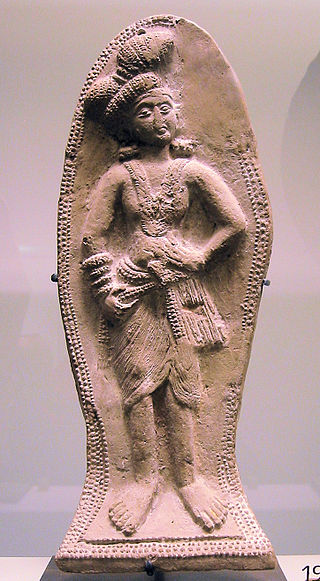
Pushyamitra Shunga or Pushpamitra Shunga was the co-founder and the first or second ruler of the Shunga Empire which he and Gopāla established to succeed the Maurya Empire. His original name was Puṣpaka or Puṣpamitra and the confusion between Puṣyamitra and Puṣpamitra arose because of the erroneous readings of 'p' and 'y' in the manuscripts.
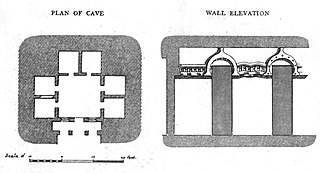
Vihāra generally refers to a Buddhist monastery for Buddhist renunciates, mostly in the Indian subcontinent. The concept is ancient and in early Sanskrit and Pali texts, it meant any arrangement of space or facilities for dwellings. The term evolved into an architectural concept wherein it refers to living quarters for monks with an open shared space or courtyard, particularly in Buddhism. The term is also found in Ajivika, Hindu and Jain monastic literature, usually referring to temporary refuge for wandering monks or nuns during the annual Indian monsoons. In modern Jainism, the monks continue to wander from town to town except during the rainy season (Chaturmas), and the term "vihara" refers to their wanderings.
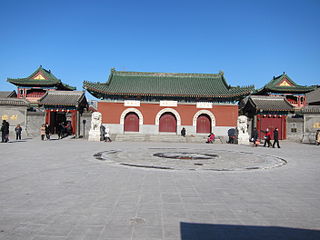
The Temple of Great Compassion or Dabei Yuan is a Chan Buddhist temple in Tianjin, China.

Vikramashila was one of the three most important Buddhist monasteries in India during the Pala Empire, along with Nalanda and Odantapuri. Its location is now the site of Antichak village near Kahalgaon, Bhagalpur district in Bihar.
Sangharama refers to a "temple" or "monastery." It is the place, including its garden or grove, where the Sangha, the Buddhist monastic community dwells. A famous sangharāma was that of Kukkutarama in Pataliputra. The Kukkutura sangharāma was later destroyed and its monks killed by Pushyamitra of Mauryan lineage, according to the second century Ashokavadana. "Then King Pushyamitra equipped a fourfold army, and intending to destroy the Buddhist religion, he went to the Kukkutarama. (...) Pushyamitra therefore destroyed the sangharāma, killed the monks there, and departed."
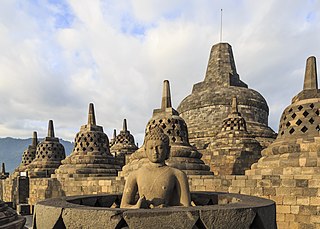
Buddhist religious architecture developed in the Indian subcontinent. Three types of structures are associated with the religious architecture of early Buddhism: monasteries (viharas), places to venerate relics (stupas), and shrines or prayer halls, which later came to be called temples in some places.

Namgyal Monastery is currently located in Mcleod Ganj, Dharamsala, India. It is the personal monastery of the 14th Dalai Lama. Another name for this temple-complex is Namgyal Tantric College.

Mindrolling Monastery, is one of the "Six Mother Monasteries" of the Nyingma school in Tibet. It was founded by Rigzin Terdak Lingpa in 1676. Tendrak Lingpa's lineage is known as the Nyo lineage. The name in Tibetan means "Place of Perfect Emancipation". It is located in Zhanang County, Shannan Prefecture, Tibet Autonomous Region, China, known as U-Tsang. Mindrolling Monastery is approximately 43 kilometers east of the Lhasa airport, on the south side of the Tsangpo river.

Jetavana was one of the most famous of the Buddhist monasteries or viharas in India. It was the second vihara donated to Gautama Buddha after the Venuvana in Rajgir. The monastery was given to him by his chief male patron, Anathapindika.
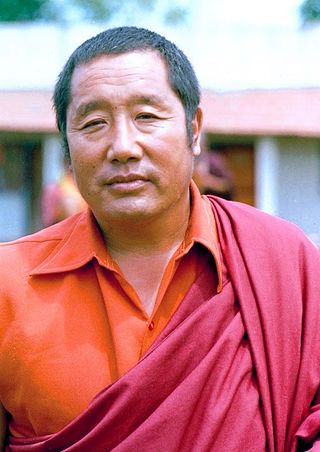
Kyabjé Drubwang Padma Norbu Rinpoche, 1932 – 27 March 2009, was the 11th throneholder of the Palyul Lineage of the Nyingma school of Tibetan Buddhism, and said to be an incarnation of Vimalamitra. He was widely renowned in the Tibetan Buddhist world as a master of Dzogchen. He was one of a very few teachers left from his generation who received all his training in Tibet under the guidance of what Tibetan Buddhists consider to be fully enlightened teachers.
The Ashokavadana is an Indian Sanskrit-language text that describes the birth and reign of the third Mauryan Emperor Ashoka. It contains legends as well as historical narratives, and glorifies Ashoka as a Buddhist emperor whose only ambition was to spread Buddhism far and wide.

Wat Umong is a 700-year-old Buddhist temple in Chiang Mai, Thailand.
Indonesian Esoteric Buddhism or Esoteric Buddhism in Maritime Southeast Asia refers to the traditions of Esoteric Buddhism found in Maritime Southeast Asia which emerged in the 7th century along the maritime trade routes and port cities of the Indonesian islands of Java and Sumatra as well as in Malaysia. These esoteric forms were spread by pilgrims and Tantric masters who received royal patronage from royal dynasties like the Sailendras and the Srivijaya. This tradition was also linked by the maritime trade routes with Indian Vajrayana, Tantric Buddhism in Sinhala, Cham and Khmer lands and in China and Japan, to the extent that it is hard to separate them completely and it is better to speak of a complex of "Esoteric Buddhism of Mediaeval Maritime Asia." Many key Indian port cities saw the growth of Esoteric Buddhism, a tradition which coexisted alongside Shaivism.

The Pemayangtse Monastery is a Buddhist monastery in Pemayangtse, near Pelling in the northeastern Indian state of Sikkim, located 110 km west of Gangtok. Planned, designed and founded by Lama Lhatsun Chempo in 1647, it is one of the oldest and premier monasteries of Sikkim, also the most famous in Sikkim. Originally started as a small Lhakhang, it was subsequently enlarged during the reign of the third Chogyal Chakdor Namgyal and Khenchen Rolpai Dorjee in the year 1705 and consecrated by the third Lhatsun Chenpo Dzogchen Jigme Pawo in the year 1710 C.E. The monastery follows the Nyingma Order of Tibetan Buddhism and controls all other monasteries of that Order in Sikkim. The monks of this monastery are normally chosen from the Bhutias of Sikkim.

Tashiding Monastery is a Buddhist monastery of the Nyingma sect of Tibetan Buddhism in Western Sikkim, northeastern India, which is the most sacred and holiest monasteries in Sikkim. It is described as the "Heart of Sikkim/Denzong", citing to its importance of religious sacredness. It is located on top of the hill rising between the Rathong chu and the Rangeet River, 40 kilometres (25 mi) from Gyalshing and 19 kilometres (12 mi) to the south east of Yuksam. The annual festival of Bumchu, meaning ~Holy water~ takes place on the 14th and 15th of the 1st month of Tibetan lunar calendar, often around the months of February and March. The festival is believed to predict the upcoming forecasts and events for Sikkim in the coming year. Undoubtedly, one of the most important and holiest festivals for all the Buddhists in Sikkim and around, it also provides for a perfect platform for all those Non-Buddhists who seek a deeper insight into Buddhism and its religious customs, beliefs and rituals. History of the Festival- Somewhere between 755 and 804 CE in Tibet under the reign of King Trisong Deutsen. It was under his rule that Guru Padmasambhava when invited to Tibet performed a holy sadhana and consecrated the land with water from his SACRED VASE, which was then later concealed as a hidden treasure in his most blessed place, the Tashiding Monastery in Sikkim. Somewhere around 17th century, the vase was again discovered by one of the reincarnations of Padmasambhava and it is since that time, this festival again resumed with all its glory and splendour in the hidden and blessed land of Sikkim/Beyul Demozong. Tashiding is the nearest town to the Tashiding Monastery (Gompa)

Yijing, formerly romanized as I-ching or I-tsing, born Zhang Wenming, was a Tang-era Chinese Buddhist monk famed as a traveller and translator. His account of his travels is an important source for the history of the medieval kingdoms along the sea route between China and India, especially Srivijaya in Indonesia. He also gave accounts of the Gupta Period. A student of the Buddhist university at Nālandā, he was also responsible for the translation of many Buddhist texts from Sanskrit and Pali into Chinese.
References
- ↑ Bibhuti Baruah (2000). Buddhist Sects and Sectarianism. Sarup & Sons. pp. 40–41. ISBN 978-81-7625-152-5.
- ↑ Lahiri 1974.
Bibliography
- Lahiri, Bela (1974). Indigenous states of northern India, circa 200 B.C. to 320 A.D. University of Calcutta. p. 31.